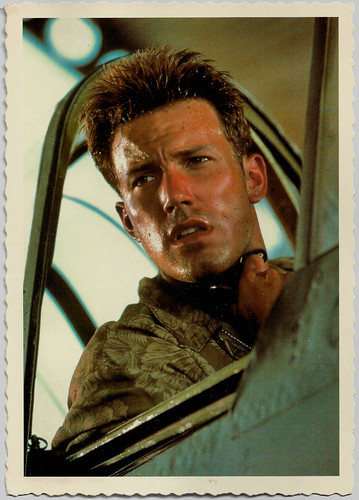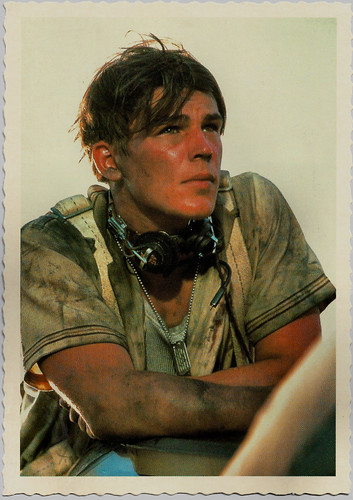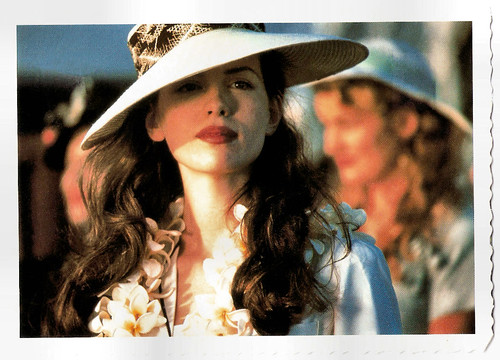
German postcard. Photo: Touchstone Pictures / Bueno Vista International. Ben Affleck in Pearl Harbor (Michael Bay, 2001).

German postcard by Edgar Medien AG. Photo: Touchstone Pictures / Bueno Vista International. Kate Beckinsale in Pearl Harbor (Michael Bay, 2001).

German postcard. Photo: Touchstone Pictures / Bueno Vista International. Josh Hartnett in Pearl Harbor (Michael Bay, 2001).
Budget fights continued throughout the planning of the film
Pearl Harbor (Michael Bay, 2001) is a classic tale of romance set during a war that complicates everything. It all starts when childhood friends Rafe (Ben Affleck) and Danny (Josh Hartnett) become Army Air Corps pilots and meet Evelyn (Kate Beckinsale), a Navy nurse. Rafe falls head over heels and he and Evelyn and Rafe hook up.
Then Rafe volunteers to go fight in Britain, and Evelyn and Danny get transferred to Pearl Harbor. While Rafe is off fighting, suddenly one morning comes the air raid we now know as 'Pearl Harbor'.
The film had a proposed budget of $208 million which Michael Bay and Jerry Bruckheimer wanted. This was an area of contention with Disney executives since a great deal of the budget was to be expended on production aspects.
Also controversial was the effort to change the film's rating from R to PG-13. Bay initially wanted to graphically portray the horrors of war and was not interested in primarily marketing the final product to a teen and young adult audience. However, even though he wanted to make an R-rated movie, Bay admitted that the problem was that young children would not be able to see it, and he felt that they should. As such, when he was ordered by Disney to make a PG-13 movie, he didn't argue.
As a compromise, he was allowed to release an R-rated Director's Cut on DVD later on in 2002. Budget fights continued throughout the planning of the film, with Bay "walking" on several occasions. Dick Cook, chairman of Disney at the time, said "I think Pearl Harbor was one of the most difficult shoots of modern history."
In order to recreate the atmosphere of pre-war Pearl Harbor, the producers staged the film in Hawaii and used current naval facilities. Many active-duty military members stationed in Hawaii and members of the local population served as extras during the filming.
The set at Rosarito Beach in the Mexican state of Baja California was used for scale model work as required. Formerly the set of Titanic (James Cameron, 1997), Rosarito was the ideal location to recreate the death throes of the battleships in the Pearl Harbor attack.
A large-scale model of the bow section of USS Oklahoma mounted on the world's largest gimbal produced an authentic rolling and submerging of the doomed battleship. Production Engineer Nigel Phelps stated that the sequence of the ship rolling out of the water and slapping down would involve one of the "biggest set elements" to be staged.
Matched with computer-generated imagery, the action had to reflect precision and accuracy throughout. The vessel most seen in Pearl Harbor was USS Lexington, representing both USS Hornet and a Japanese carrier. All aircraft take-offs during the movie were filmed on board the Lexington, a museum ship in Corpus Christi, Texas.
The aircraft on display was removed for filming and replaced with film aircraft as well as World War II anti-aircraft turrets. Other ships used in filler scenes included USS Hornet, and USS Constellation during filming for the carrier sequences. Filming was also done onboard the museum battleship USS Texas located near Houston, Texas.

Australian postcard by Avant Card, no. 1 in a series of 5. Photo: Jerry Bruckheimer Films / Buena Vista International / Touchstone Pictures. Publicity still for Pearl Harbor (Michael Bay, 2001).

Australian postcard by Avant Card, no. 3 in a series of 5. Photo: Jerry Bruckheimer Films / Buena Vista International / Touchstone Pictures. Kate Beckinsale in Pearl Harbor (Michael Bay, 2001).
The world's largest and most expensive outdoor theater
Disney chose to premiere Pearl Harbor (Michael Bay, 2001) inside Pearl Harbor itself, aboard the active nuclear aircraft carrier USS John C. Stennis, which made a six-day trip from San Diego to serve as "the world's largest and most expensive outdoor theater".
More than 2,000 people attended the premiere on the Stennis, which had special grandstand seating and one of the world's largest film screens assembled on the flight deck. The guests included various Hawaii political leaders, most of the lead actors from the film, and over 500 news media from around the world that Disney flew in to cover the event. The party was estimated to have cost Disney $5 million.
Pearl Harbor was a box office success, earning $59 million in its opening weekend. In total, the film grossed $198,542,554 at the domestic box office and $250,678,391 overseas for a worldwide total of $449,220,945, ahead of Shrek (Andrew Adamson, Vicky Jenson, 2001). The film was ranked the sixth highest-earning picture of 2001.
Pearl Harbor received mostly negative reviews from critics. Roger Ebert of the Chicago Sun-Times gave the film one and a half stars, writing: "Pearl Harbor is a two-hour movie squeezed into three hours, about how, on Dec. 7, 1941, the Japanese staged a surprise attack on an American love triangle. Its centerpiece is 40 minutes of redundant special effects, surrounded by a love story of stunning banality. The film has been directed without grace, vision, or originality, and although you may walk out quoting lines of dialogue, it will not be because you admire them."
Ebert also criticised the liberties the film took with historical facts: "There is no sense of history, strategy or context; according to this movie, Japan attacked Pearl Harbor because America cut off its oil supply, and they were down to an 18-month reserve. Would going to war restore the fuel sources? Did they perhaps also have imperialist designs? Movie doesn't say."
In his later "Great Movies" essay on Lawrence of Arabia, Ebert likewise wrote, "What you realize watching Lawrence of Arabia (David Lean, 1962) is that the word 'epic' refers not to the cost or the elaborate production, but to the size of the ideas and vision. Werner Herzog's Aguirre, the Wrath of God didn't cost as much as the catering in Pearl Harbor, but it is an epic, and Pearl Harbor is not."
Other reviewers criticised the story, long runtime, screenplay and dialogue, pacing, performances, and historical inaccuracies. It was nominated for four Academy Awards, winning in the category of Best Sound Editing. However, it was also nominated for six Golden Raspberry Awards, including Worst Picture. This marked the first occurrence of a Worst Picture-nominated film winning an Academy Award.

German postcard by Edgar Medien AG. Photo: Touchstone Pictures / Bueno Vista International. Kate Beckinsale and Josh Hartnett in Pearl Harbor (Michael Bay, 2001).

German postcard by Edgar Medien AG. Photo: Touchstone Pictures / Bueno Vista International. Kate Beckinsale in Pearl Harbor (Michael Bay, 2001).

German postcard by Edgar Medien AG. Photo: Touchstone Pictures / Bueno Vista International. Kate Beckinsale in Pearl Harbor (Michael Bay, 2001).
Sources: Wikipedia and IMDb.
1 comment:
My dad always heckles me with Rafe’s “HAMMER DOWN!” Thank goodness we have Tora! Tora! Tora! instead. Some people think a missed opportunity was made to make Miller the main character (i think a film about Miller and his fellow messmates would be interesting. Besides Miller, there was George Bland, and Clark Simmons. Bland and Miller served as mess attendants on the USS West Virginia, where Miller pursued boxing as a sport. Simmons served as mess attendant on the USS Utah. They were recently the subject of a Pearl Harbor episode on a short series called “Erased: WW2’s Heroes of Color.” One helped fellow wounded white sailors, despite being the target of abuse of several casual and brutal racist remarks from them prior to the attack; when asked by his daughter on why he helped them, despite their previous behaviour, he tearfully said that in that moment, he put their prior remarks aside, and saw just saw especially at the heights of their misery, as people recognizable as fellow human beings deserving of compassion. ) as Cuba did the best he could with his short screen time, through it could be debated how accurate it is. As it stands, I'll take the more accurate, and humble, though no less heroic depiction of Doris Miller's actions (actor Elven Havard) in Tora Tora Tora, then Cuba Gooding's any day.
Post a Comment